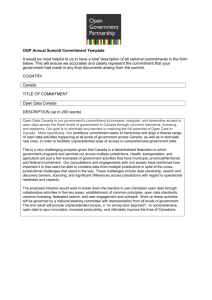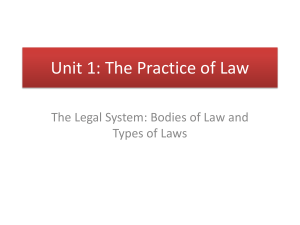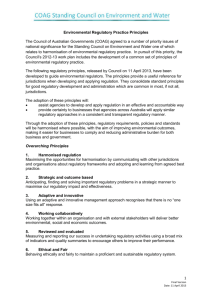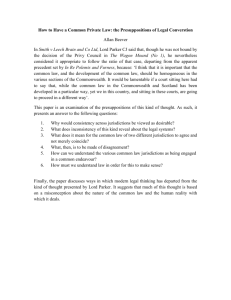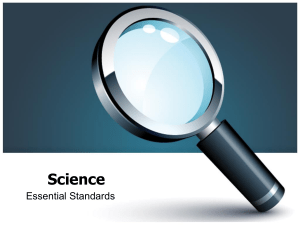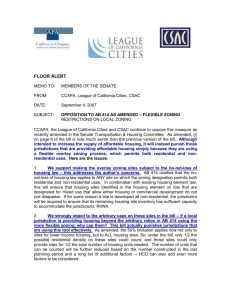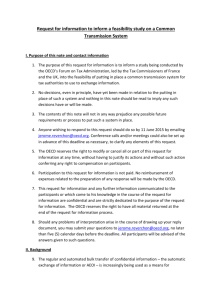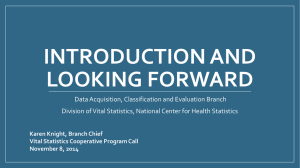Point-in-time publication of legislation (XML and legislation)
advertisement
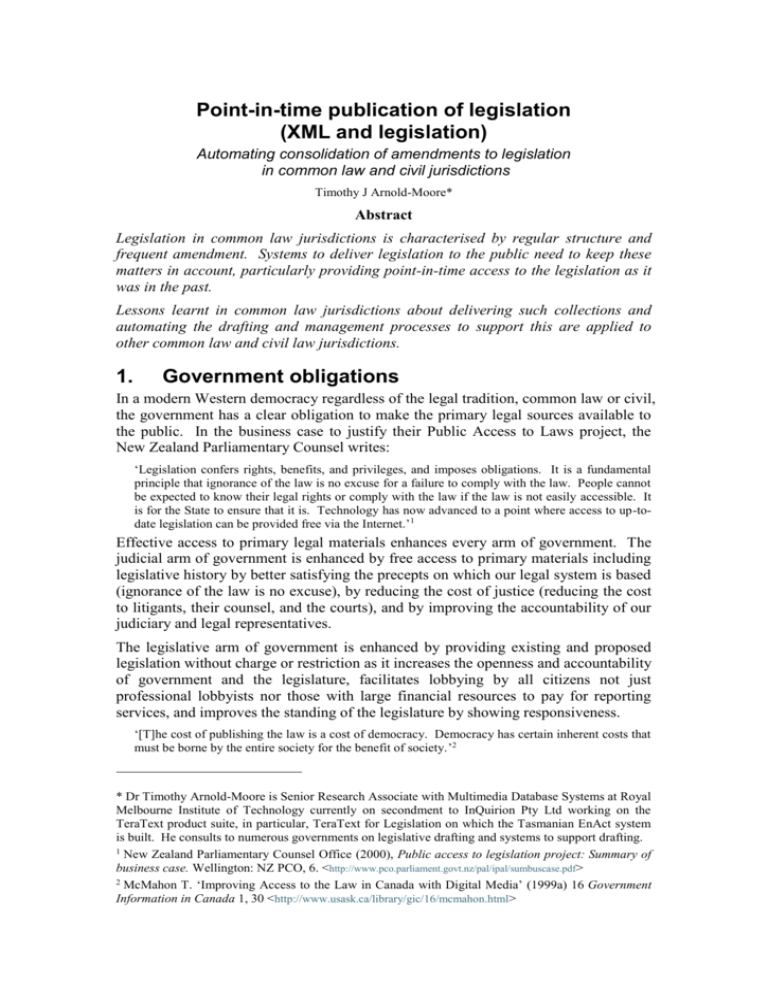
Point-in-time publication of legislation (XML and legislation) Automating consolidation of amendments to legislation in common law and civil jurisdictions Timothy J Arnold-Moore* Abstract Legislation in common law jurisdictions is characterised by regular structure and frequent amendment. Systems to deliver legislation to the public need to keep these matters in account, particularly providing point-in-time access to the legislation as it was in the past. Lessons learnt in common law jurisdictions about delivering such collections and automating the drafting and management processes to support this are applied to other common law and civil law jurisdictions. 1. Government obligations In a modern Western democracy regardless of the legal tradition, common law or civil, the government has a clear obligation to make the primary legal sources available to the public. In the business case to justify their Public Access to Laws project, the New Zealand Parliamentary Counsel writes: ‘Legislation confers rights, benefits, and privileges, and imposes obligations. It is a fundamental principle that ignorance of the law is no excuse for a failure to comply with the law. People cannot be expected to know their legal rights or comply with the law if the law is not easily accessible. It is for the State to ensure that it is. Technology has now advanced to a point where access to up-todate legislation can be provided free via the Internet.’ 1 Effective access to primary legal materials enhances every arm of government. The judicial arm of government is enhanced by free access to primary materials including legislative history by better satisfying the precepts on which our legal system is based (ignorance of the law is no excuse), by reducing the cost of justice (reducing the cost to litigants, their counsel, and the courts), and by improving the accountability of our judiciary and legal representatives. The legislative arm of government is enhanced by providing existing and proposed legislation without charge or restriction as it increases the openness and accountability of government and the legislature, facilitates lobbying by all citizens not just professional lobbyists nor those with large financial resources to pay for reporting services, and improves the standing of the legislature by showing responsiveness. ‘[T]he cost of publishing the law is a cost of democracy. Democracy has certain inherent costs that must be borne by the entire society for the benefit of society.’2 * Dr Timothy Arnold-Moore is Senior Research Associate with Multimedia Database Systems at Royal Melbourne Institute of Technology currently on secondment to InQuirion Pty Ltd working on the TeraText product suite, in particular, TeraText for Legislation on which the Tasmanian EnAct system is built. He consults to numerous governments on legislative drafting and systems to support drafting. 1 New Zealand Parliamentary Counsel Office (2000), Public access to legislation project: Summary of business case. Wellington: NZ PCO, 6. <http://www.pco.parliament.govt.nz/pal/ipal/sumbuscase.pdf> 2 McMahon T. ‘Improving Access to the Law in Canada with Digital Media’ (1999a) 16 Government Information in Canada 1, 30 <http://www.usask.ca/library/gic/16/mcmahon.html> The executive branch of government is enhanced by better access to legislative material by assisting citizens to comply and thereby reducing the cost and effort required to police and enforce it. Better accessibility to the legal framework under which the public service works enhances their accountability. The public service is amongst the largest users of legislative publications and better Internet access can reduce the costs to government and enhance the efficiency of the public service. The purpose behind the great Codes of the civil jurisdictions was always to make available to its citizens the entire law – providing a single source to consult to discover their legal rights and obligations. Therefore, in civil law jurisdictions, the Codes and statutory law are the primary sources and the obligation to make them available is widely acknowledged. The Codes together with the various auxiliary laws must be made widely and freely available to achieve this objective. In common law jurisdictions, case law is also an important source, primarily for the judicial arm. As the Statute Book expands to cover more and more categories and globalization forces harmonization of laws between nations, the importance of legislation in the English tradition is growing and case law is increasingly used as it is in the civil tradition – to guide the interpretation of the statutes, rather than to declare and shape the law. In this paper we will focus on legislation in both traditions and, since anything said of primary legislation also applies to subordinate legislation made under delegated authority, this paper focuses on Codes and enactments. 2. The nature of legislative documents 2.1. In the common law tradition Aggressive British colonization in the 17th, 18th, and 19th centuries spread the English common law tradition, along with its legislative practices to countries across the world. Primarily in current and former member countries of the Commonwealth, but also in the USA and countries strongly influenced by the USA, this has lead to a remarkably consistent practice across the Anglophone world. Legislation in Anglophone countries is primarily drafted by professional legislative drafters attached to the legislature (or the government). This generally leads to very uniform practice within a jurisdiction, and remarkable consistency in procedure, styles and nomenclature between jurisdictions. Much has been written elsewhere about the unique characteristics of legislation in Anglophone jurisdictions.3 A brief summary follows. 2.1.1. Dense and regular structure Drawing on the drafting conventions of the original Parliamentary Counsel which emerged in England in the 18th and 19th century, all Acts are divided into sections (in subordinate legislation these are called variously sections, clauses, rules, regulations or orders). Sections are grouped in some or all of Chapters, Parts, Subparts, Divisions, Arnold-Moore, T. and Clemes, J. ‘Connected to the law: Tasmanian legislation using EnAct’, 2000 The Journal of Information, Law and Technology (JILT) 1. <http://elj.warwick.ac.uk/jilt/001/arnold.html>; Arnold-Moore, T Information systems for Legislation (1997) Ph. D Thesis, <http://www.mds.rmit.edu.au/~tja/thesis/index.html>; Arnold-Moore, T ‘About time: legislation’s forgotten dimension’ in AustLII Law via the Internet Conference Sydney:AustLII (2001). <http://www.mds.rmit.edu.au/~tja/papers/li2001.pdf>. 3 Subdivisions, and under unnumbered, unnamed headings. Each section has a sidenote or headnote (occasionally called a heading or title) and is itself divided into subsections, definitions, paragraphs (or clauses), and subparagraphs. With the exception of definitions, each of these constructs is numbered remarkably consistently within jurisdictions and, more remarkably, consistently across jurisdictions. Different types of numbers are associated with different structures e.g. sections are almost always numbered using Arabic numbers starting from the first section and not renumbered within grouping elements. Paragraphs are numbered using bracketed alphabetic designators restarted within each new context in which they appear. When new sections are inserted, the existing sections are not renumbered but the new sections are numbered using either a decimal system (common in Canada and some US States) or by following the number with an alphabetic extension e.g. new sections inserted between sections 5 and 6 are numbered 5A, 5B, 5C, etc. The regularity of this structure and the consistent naming of its components make structured markup approaches appropriate, such as envisaged by document exchange standards SGML and XML. 2.1.2. Extensive amendment over time Legislation is not static. A large proportion of legislation in any Anglophone jurisdiction (as much as 80%)4 does not introduce new laws but rather modifies the text of existing laws. Some legislation, particularly tax legislation, may be amended many times a year. In the English tradition, it is considered unjust to judge a person’s action according to a law that was not known to them at the time. For this reason, retrospective legislation is typically avoided, particularly where it alters accrued rights or creates a new crime. Therefore, these amendments are typically effective going forward from the time of their creation. Those Acts and rules that amend existing legislation typically describe textual operations to alter the text of the current version. What most users of legislation desire is consolidated or compiled legislation – legislation with all of the relevant amendments applied. ‘Ascertaining the exact state of the law (as it is contained in legislation) can be difficult when there is a series of amendments to an enactment and these have not been incorporated in to the principal enactment. It becomes a question whether in fact the law is available. The process of compilation is designed to produce an accurate and up-to-date statement of the law. In this way, the compilation process is a key aspect of making legislation accessible.’5 This leads to multiple versions of any significant piece of legislation determined by when the amendments to them came into force. This is true whether the legislation is codified or not. These versions can typically be uniquely identified by traditional citation of the document plus a single date (as is the common practice in the library community) although two dates are required to uniquely determine the text of a consolidated version of legislation. 6 Every authorised consolidated version of legislation in Tasmania is marked with two dates – the date on which the legislation is in force (“in force” or valid time) and the date at which the status of the legislation 4 Arnold-Moore (1997). New Zealand Parliamentary Counsel Office Public access to legislation: A discussion paper for public comment. Wellington: NZ PCO (1998), ¶3.1.5 http://www.pco.parliament.govt.nz/pal/papers.html. 6 Arnold-Moore (2001), §4. 5 was known incorporating all legislation made until that date (“current through”, “as of”, or transaction time). 2.1.3. Longevity The last significant characteristic of legislation is its longevity. The typical office document has a life-time measured in weeks or months. Anything more than a year or two is exceptional. A typical Act might be in force for decades. Parts of the Magna Carta (1215) are still in force in many Anglophone jurisdictions. 2.2. Distinctives of the civil law tradition Applying lessons learned in the English tradition slavishly to other jurisdictions would be a mistake. Any systems, technological or otherwise, carried from one jurisdiction to another must take account of the significant cultural and legal differences between the jurisdictions. Care must still be taken not to overemphasize these differences as they have been in the past. 2.2.1. Primacy of statute law The obvious difference between civil and common law jurisdictions is that legal decisions are primarily influenced by statute law in civil jurisdictions.7 Common law court decisions typically start with a recitation of the facts. Civil court decisions typically start with a recitation of the relevant provision and invariably are based on one or more provisions. The English Court of Appeals now makes as much as 90% of their judgments based on the interpretation of one or more statutory provisions8 and most other common law courts would be similar. As the Statute Book grows to encompass every aspect of human endeavour, this is only likely to increase. 2.2.2. Codification It is not just that statute law is the primary source for all law in civil jurisdictions. The great Codes attempted to collect all of the sources together, classified by subject. Some common law jurisdictions have followed this lead, especially in the US. These codes may have force of law (the term “positive law” is used to describe the 23 titles in the US Code that have force of law) or they may be just a convenient collection of the underlying statutes (the term “non-positive law” is used to describe the remaining titles in the US Code). Practice in the US States varies but is usually not mixed as in the federal arena. The US provides an official version of the Code (the United States Code or USC) which is often up to 2 years out-of-date and commercial publishers provide unofficial but more timely versions – the USC Annotated (USCA) and the USC Service (USCS). In civil jurisdictions, auxiliary enactments have the force of the law but are not part of a Code. Like non-positive law in the US, they are sometimes unofficially incorporated into a Code or Codes. These auxiliary enactments behave much more like statute law in the English tradition – they augment the law and provide a Germain, C “Approaches to statutory interpretation and legislative history in France” (2003) 13 Duke Journal of Comparative and International Law 195, 195. 8 Lord Hailsham, “Hamlyn Revisited: The British Legal System Today” (Hamlyn Lectures), 65 as cited Bennion, F Statutory Interpretation—A Code 3rd ed (1997). See generally Kirby, M “Towards a grand theory of interpretation: the case of statutes and contracts” (2003) 24 Statute Law Review 95. 7 codification of a narrow and specific area of the law and do not necessarily form part of a unified body of law. It should be noted that nearly all common law jurisdictions have codified part of their law. The UK parliament enacted the Criminal Code, to codify the mostly common law offences in 18??. New York enacted Field’s Code of Civil Procedure in 1848 which was widely adopted throughout the United States.9 2.2.3. Broad principles v. exhaustive recitation It has been noted that legislative material in the Anglophone tradition is much more verbose than civil tradition counter-parts, which tend to state policy rather than exhaustively explore every possible interpretation.10 Statutes in the English tradition codify a particular area of the law. They tend to be exhaustive limiting the scope for interpretation of the courts precisely because they are often only enacted to correct a perceived error in the direction in which the courts are going. In this, the 200th anniversary year of the Napoleonic Code, it is important to recognize that the Code was a masterful piece of literature as well as legal drafting. 11 Stendahl was known to read it every day for the quality of the text.12 The drafters’ intent was to unite the French Empire under a single set of laws broadly accessible to the entire population. Portalis, one of the primary drafters of the Napoleonic Code noted at the opening of the conferences “we were impressed by the opinion, so generally held, that in drafting a civil code a few very precise provisions upon each subject would suffice, and that the great art was to simplify all by anticipating all.”13 The Counseil d’Etat continues to strive to maintain this high standard. The complaint of verbosity has also been levelled against the German Civil Code.14 Sir William Dale in comparing copyright law in France, Sweden, Germany, the UK and Canada observes that the civil jurisdictions all share a similar level of detail to the common law equivalents, if avoiding the practice of excessive definition.15 This difference is more a historical artefact than a philosophical divergence and “plain-language” drafting is widely discussed and practiced in Anglophone drafting circles. The Renton Report16 recommended a number of changes to English drafting practices to better reflect some of the advantages of the civil law approach to drafting. 9 Field (2003), 79. The preparation of legislation (the Renton Report) (1975) Cmnd 6053 HMSO:London. See also Dale, W Legislative drafting: A new approach Butterworths:London (1977); Campbell, L (1996) “Legal drafting styles: fuzzy or fussy?” 3 E-Law 2; Tetley, W “Mixed jurisdictions: common law vs civil law (codified and uncodified) Part I” [1999] 3 Uniform Law Review 591, ¶V.8. <http://www.murdoch.edu.au/elaw/issues/v3n2/campbell.html> 11 Head, J “Codes, cultures, chaos, and champions: common features of legal codification experiences in China, Europe, and North America” (2003) 13 Duke Journal of Comparative and International Law 1, 43. 12 Dale (1977), 88. 13 Holmberg, T (2002) The Civil Code (the Code Napoléon) <http://www.napoleonseries.org/articles/government/civilcode.cfm> 14 Germain (2003). 15 Dale (1977), 74. This view is affirmed by Stone, A , “Bilingual drafting in a common law jurisdiction in Canada” in Proceedings of the Uniform Law Conference of Canada Department of Justice:Ottawa (1985). 16 Op cit. 10 While England has been slow to adopt some of these practices, 17 most other Anglophone jurisdictions were already well on the way to achieving some of its aims before the report was delivered. The referential style of amendment heavily criticised in the Renton Report was rarely used outside of tax legislation in any other Anglophone jurisdiction. The briefer style typified by the Napoleonic Code was adopted for Field’s Code of Civil Procedure enacted in most US jurisdictions.18 Regardless, the historical legacy of verbose drafting means that providing sophisticated access to legislative material is more important in Anglophone jurisdictions as it is more expensive for users to compile and collect comprehensive collections. However, the barrier for civil law jurisdictions to provide these resources is lower as the volume of material to manage should be lower. 2.2.4. Drafting office In Anglophone jurisdictions, most significant legislation is drafted in a centralized legislative drafting office styled after the British Office of Parliamentary Counsel (often called Legislative Counsel in the US and Canada). It is far less common in civil jurisdictions to have a centralized pool of professional drafters draft legislation. Legislation is more normally drafted in government departments (e.g. Japan) or by a commission appointed to the task (e.g. Sweden) or a mixture of both (e.g. France). Typically, a centralized body will review and refine the proposed legislation (e.g. France’s Conseil d’Etat19 or the Swedish Law Council).20 2.2.5. Use of legislative history In the civil tradition, the primary focus is to discover the intent of the legislator by looking at the text and the context in which it was created – the “travaux préparatoires”.21 For this purpose, it has long been recognized in civil jurisdictions that, where a legislative provision is ambiguous, the courts may resort to the legislative debates, law reform reports, and other material to ascertain the intent of the legislature.22 The English tradition has been to use this material only to identify the wrong being addressed, but not to identify the manner of addressing it 23 although US courts adopted a more flexible approach. 24 Some senior judges in the UK 25 and Glaisdale, Lord Simon, “The Renton Report – ten years on” [1985] Statute Law Review 133, 134. Field (2003), 79. 19 Massot, J “Legislative drafting in France: the role of the Conseil d' Etat” (2001) 22 Statute Law Review 96. Massot observes that “such an institution exists [sic] since the XIXth century in about 20 countries throughout the world, for instance Greece, Italy, Belgium or the Netherlands in Western Europe, Lebanon and Egypt in the Middle East, Columbia in Latin America and Thailand in Asia.” p. 97. See also Dale (1977), 83ff. 20 Dale (1977), 97ff. 21 Tetley (2003a) ¶V.9. 22 Germain (2003). 23 Pearce, D Statutory Interpretation in Australia 2nd ed Butterworths:Sydney (1981), ¶77ff. See also Matadeen v Pointu [1999] 1 AC 98, 108 (House of Lords); Re Bolton; Ex parte Beane (1987) 162 CLR 514, 518 (High Court of Australia); and Byrne v Australian Airlines Ltd (1995) 185 CLR 410, 459 (High Court of Australia). 24 Dugan v Mirror Newspapers [1978] HCA 54 per Stephen J [23] choosing with the majority not to make use of extrinsic material. 25 Per Lord Simon of Glaidsdale McMillan v. Crouch [1972] 1 WLR 1102, 1119 (rejected by Mason J in Consumer and Prices CA v Moore [19]. 17 18 Australia 26 have shown themselves much more willing to use extrinsic material. Many jurisdictions have intervened with legislation.27 Kirby J notes that “the trend towards the reception of extrinsic materials in support of [statutory interpretation] has gathered pace.” 28 This specific symptom of a more general trend to “purposive” interpretation in common law courts following the civil law tradition is also observed by Kirby J29 in England,30 Ireland,31 and Australia.32 2.3. Similarities between civil and common law legislation The differences between common law and civil law jurisdictions are often overemphasized. 33 As in Westminster governments (the majority of Anglophone jurisdictions outside of the US), the vast majority of Acts start as government bills (projets de lois). 34 Although the civil jurisdictions criticise the common law as “judge-made”, judges frequently draft legislation in civil jurisdictions.35 Just as this “judge-made” law is scrutinized by the legislature in civil jurisdictions, bad “judgemade” law leads to more litigation so necessarily leads to more intense scrutiny and review by the judiciary36 or, in extreme cases, by the legislature. The increasing use of judicial decisions in the civil jurisdictions combined with the expansion of the coverage of statute law in common law jurisdictions means that real distinctions are being reduced.37 Structure is also regular and dense in civil law statutes and Codes. Although centralized drafting is less common, centralized review of proposed drafts is more universal in civil jurisdictions so the effect is a similar level of structural uniformity at least within each different Code. Between civil jurisdictions (and different Codes within a single jurisdiction) there is less uniformity. Unlike Anglophone jurisdictions where nomenclature of structural building blocks is virtually universal, because civil jurisdictions cover multiple languages, structural elements, while filling the same function, have different names. Taking this into account, the structural building blocks of legislation in civil jurisdictions is not much more variable than between Anglophone jurisdictions. This is largely attributable to the shared influence of the great historical codes such as the Codex Justinianus of 529 which in turn influenced the Code Napolean of 1804 and the Bürgerliches Gesetzbuch (German Civil Code) of 26 Per Murphy J Dugan v Mirror Newspapers [1978] HCA 54 [23-8] Acts Interpretation Act 1901 (Cth) s. 15AA which is substantially reproduced in all Australian states and territories. See also CIC Insurance Ltd v Bankstown Football Club Ltd (1997) 187 CLR 384, 408 (Joint judgment of 4 High Court judges). 28 Kirby (2003), 103. 29 Ibid. 104. 30 Per Lord Griffiths Pepper v. Hart [1993] AC 593, 617. 31 Per Denham J DPP (Ivers) v. Murphy [1999] 1 ILRM 46. 32 Per McHugh JA Kingston v. Keprose Pty Ltd (1987) 11 NSWLR 404, 423–4 approved Bropho v. Western Australia (1990) 171 CLR 1,20. 33 Shapiro, M “The success of judicial review” in Kenney, Reisinger, & Reitz (eds) Constitutional dialogues in comparative perspective New York:St Martin’s Press (1999); Campbell, 1996 ¶1 op cit. 34 Ibid. 98. 35 See generally Dale (1977). 36 Kerkmester, H & Visscher, L “Learned Hand in Europe: a study of comparative law and economics of negligence” [2003] German Working Papers in Law and Economics 6, 1. 37 Kerkmester & Visscher (2003), 2. 27 1900. Most codes in civil jurisdictions trace their origins back to one or more of these codes.38 While the Codes tend not to be amended quite as frequently as in English speaking jurisdictions, civil jurisdictions share the reluctance to make amendments retrospective in their effect. 39 Civil jurisdictions share the need for consolidated versions as they also make frequent use of textual amendments. It is noted that the Rapporteur gives two reports on a French draft bill, one which sets the scene and the other describes the actual textual effect giving the pre-existing law and the effect of the changes. 40 The importance of tracking changes is recognized in the drafting process itself. With respect to longevity, many of the provisions of the Napoleonic Code have not been amended. Civil jurisdictions can often trace provisions back to the Codex Justinius (529)! In some ways, auxiliary enactments in the civil law tradition are very similar to statutes in the common law tradition. Stone, then Senior Legislative Counsel of Ontario, wrote: “[t]he principles expressed in the Civil Code as pure general principles are expressed in the common law, as generally stated flexible principles in decided cases. The statute law outside the Civil Code is the counterpart of English statute law. In practice in Canada, the attributes of the Civil Code are not found in French statute law. French statutes address the same procedural and administrative detail as the English statutes do in the same subject matter. On the other hand, common law concepts such as reasonableness, good faith and fault and negligence are commonly stated unadorned in English statutes and are troublesome to French translators who look for greater specificity. The quality of English drafting varies but, in the case of well drafted statutes in either language, the differences are not as great as is generally assumed.” 41 These auxiliary enactments or statutes are much more difficult to manage the Codes and are often overlooked in designing an electronic system to deliver a complete repository of legislative sources to the public. 2.4. Mixed jurisdictions The increasing unification of Europe as a federation, the pressures of global commerce, and increasingly global communication all encourage sharing between common law and civil law traditions. As these trends continue, we have much to learn from the so-called ‘mixed jurisdictions’. These include civil codified jurisdictions within a common law federal environment such as Québec and Louisiana, common law jurisdictions within a civil law federal environment (possibly the UK within the European federation), as well as truly mixed jurisdictions that apply a mixture of Roman law and common law without a code such as Scotland and South Africa.42 Many of these jurisdictions have struggled with mixing and synchronizing terminology from both traditions and can provide guidance to purer jurisdictions in 38 This is almost E.g. Article 16 Declaration of the Human and Citizen Rights (France) (1789). 40 Germain (2003), 198. 41 Stone (1985). 42 See generally Tetley (1999a) and Tetley, W “Mixed jurisdictions: common law vs civil law (codified and uncodified) Part II” [1999b] 4 Uniform Law Review 877 39 adapting to a more global legal environment.43 In particular, the bijuralism initiatives in Canada provide an excellent starting point for communicating between Anglophone common law jurisdictions and Francophone civil law jurisdictions.44 It comes as no surprise then that Canada has a number of leading examples of legislative management systems. 3. Anglophone best practice in legislation 3.1. Point-in-time consolidated codes andChange statutes Principal Act from Markup of Description Principal Act from Markup of Change Description Database Document Database Principal Act Document(CDD) (CDD) is amending Approximately 80% of legislation inPrincipal most Act Anglophone jurisdictions SGML WordRenton ReportXML legislation. Despite slow adoption ofMSthe in the UK, all other Anglophone jurisdictions primarily useAmendment textual amendment – that is the Acts passed Amendment Wording Wording law to modify it. describe actions to be performed on the existing Generator Generator SGML Amendment AmendmentAct Act--Racing Racingand andGaming GamingAmendment Amendment(Telephone (TelephoneSports SportsBetting) Betting)Act Act1998 1998 Section Section74F 74Famended amended(Obligations (Obligationsofoflicensees) licensees) 6.6.Section Section74F 74Fofofthe thePrincipal PrincipalAct Actisisamended amendedasasfollows: follows: (a) (a) by byomitting omittingfrom fromparagraph paragraph(c) (c)"on "onGood GoodFriday FridayororChristmas Christmasday dayororatatother othertimes" times" and andsubstituting substituting"at "atany anytime"; time"; (b) (b) by byomitting omittingparagraph paragraph(d) (d)and andsubstituting substitutingthe thefollowing followingparagraph: paragraph: (d) (d)ininrespect respectofofany anybet betmade madeother otherthan thanininperson, person,must mustelectronically electronically record recordthe thebet betfor forverification verificationpurposes purposes- (i) (i)by byaadevice deviceapproved approvedby bythe theSupervising SupervisingAgency; Agency;and and (ii) (ii)ininaamanner mannerdirected directedby bythe theSupervising SupervisingAgency; Agency;and and Figure 1: An example textual amendment. What a lawyer or citizen wants when planning future activity is a complete and up-todate consolidated Statute Book as amended and in force (preferably showing uncommenced amendments as well): ‘It is a basic principle of our legal system that people are presumed to know the law. This important presumption depends on the law being readily available to people, particularly the authorised text of the law currently in force. … Access also assumes knowledge about when laws have been made, amended, repealed etc.’45 The current consolidation is important, but litigation often happens long after the events that lead to the relevant dispute. 46 Therefore the courts, and hence litigants contemplating or taking legal action must have access to not just the current version of the law but also previous versions.47 43 Head, J “Codes, cultures, chaos, and champions: common features of legal codification experiences in China, Europe, and North America” (2003) 13 Duke Journal of Comparative and International Law 1. 44 Levert, L “The Cohabitation of Bilingualism and Bijuralism in Federal Legislation in Canada: Myth or Reality?” in Harmonization and Dissonance: Language and Law in Canada and Europe (1999). Tetley (1999b), ¶XIV(a) Australian Capital Territory Parliamentary Counsels Office (2001) Legislation Act 2001: a bird’s eye view. Canberra: ACT PCO. <http://www.legislation.act.gov.au/updates/a_birds_eye_view.asp> 46 Greenleaf et al (1995) “Public access to law via Internet: the Australian Legal Information Institute” 6 Journal of Law and Information Science and Robertson and Merrick. (1994) “Proposal for participation in the Workshop on Hypertext Systems and Version Support” in Durand et al Proceedings of the Workshop on Versioning in Hypertext Systems, pp. 35-38. 47 Arnold-Moore (2001). 45 ‘The Tasmanian government uses software called “EnAct” which is a legislative drafting, management, and delivery system (go to: www.thelaw.tas.gov.au). One of its main features is that it allows users to search and browse the consolidated database as it existed at any time since February 1, 1997. These consolidations are generated automatically, without human intervention after the legislation is drafted (except to amend the draft of course). This dramatically reduces the cost of delivering this level of service. The importance of ‘point in time’ searching should not be underestimated, both for application of the law in specific lawsuits and also as an essential tool for archiving electronic copies of the laws.’48 As Anglophone jurisdictions increasingly pay attention to the legislative history of a provision, this point-in-time access takes on a new significance. “Exclusive reliance upon the reprint of regulations as amended … sometimes, in a matter of interpretation, deprives the court of the advantage of seeing how the regulations were developed by amendment and why the amendments were made. … It is not often that there is either need of or advantage in looking at the more authentic materials from which the Government Printer has reconstructed his convenient and perhaps more intelligible text. But this case happens, I think, to be such a one.”49 3.2. As originally enacted or made Consolidated legislation is important and useful, but the documents that actually have force of law are those actually made by the legislature or the body or person to whom the legislature delegated that authority. For accountability of the legislature and those entrusted with maintaining consolidations, it is vital that public access to the Acts as enacted and subordinate legislation as made is retained. In order to make the legislature and other law-makers accountable, these steps must be transparent. This means publishing status information about bills before the legislature. It means ensuring that copies of bills showing the outputs of each step in the legislative process are available. Most jurisdictions simply publish the outputs of committee proceedings as a resulting document, with no history or annotation about what was changed. However, New Zealand, with an extremely active Standing Committee process, produces Bills marked with all the changes made by a committee distinguishing between majority and unanimous changes. This shows a deep commitment to truly democratic processes unmatched in other Anglophone jurisdictions. 3.3. Role of the drafting office An authoritative source of legislation requires the government to be the publisher but there are many government agencies potentially appropriate to make legislation and related material available. Perry observes that: ‘… the Acts and Regulations Publication Act 1989 [NZ] … provides that the Chief Parliamentary Counsel (under the control of the Attorney-General) arrange for the printing and publication of Acts, Regulations and Reprints, and make them available for purchase by members of the public at places designated from time to time by the Attorney-General “at a reasonable price”.’50 The Tasmanian, New South Wales, and ACT governments have also charged the Parliamentary Counsel with managing the delivery of “as made” and consolidated 48 McMahon (1999b), 7. O’Neill v. O’Connell (1946) 72 CLR 101, 122 per Dixon J <http://www.austlii.edu.au/au/cases/cth/high_ct/72clr101.html> 50 Perry, M (1997) ‘Roadblocks to LIINZ – Problems facing public access to New Zealand’s laws’ in AustLII Law via the Internet Conference. Sydney: AustLII. 49 http://www.austlii.edu.au/au/other/CompLRes/1997/10/ legislation. In Canada, the Department of Justice Legislative Services Bureau provides the primary government drafting service and also manages the publication of legislation. In the Australian federal arena, the Office of Legislative Drafting (the body responsible for drafting subordinate legislation) within Attorney-General’s manages the day-to-day running of ScalePLUS, the official electronic publication mechanism for federal (and state) legislation, case law, and Bill materials. The reason for extending the traditional role of the official drafting office with management of the legislative repository is that they have historically maintained consolidations of legislation for their own use to facilitate the drafting of amending legislation. Rather than duplicating the effort to consolidate the amendments, the public resources used to maintain this repository should be for the benefit of all users of legislative material. If these versions are considered authoritative enough to be used as the basis for amending legislation, they should be considered sufficiently reliable for the government to endorse as authoritative. The cost of delivering these consolidations in a timely fashion to the public is a small proportion of the cost of manually maintaining these consolidations and there is no excuse for governments failing in this respect. Providing older consolidations is simply a matter of retaining old versions and providing a suitable mechanism to search and browse them. 3.4. Automating amendment generation In all known jurisdictions but Tasmania and Papua New Guinea, drafters composed amending legislation directly, combining the process of deriving the effect of the amendments with the text describing them. The Tasmanian government presented the developers with a different approach. The drafters would mark amendments directly on a consolidation of the Principal using strike-through and underline markings familiar to many lawyers. Amendment wordings for those markings would then be generated automatically. For example, to draft an amendment to section 74F of the Racing and Gaming Act 1952, a drafter would check out the appropriate version of the Act from the repository as in Figure 2. Then each change would be marked on this version using strike through and underline giving a version like that in Figure 3. Principal PrincipalAct Act--Racing Racingand andGaming GamingAct Act1952 1952 Obligations Obligationsofoflicensees licensees 74F. 74F.AAlicensee licensee- (a) (a)must mustnot notmake makebets betsexcept exceptininaccordance accordancewith withthe thelicence; licence;and and (b) (b)must mustnot, not,asasaalicensee, licensee,make makebets betson onhorse horseraces racesororgreyhound greyhoundraces; races;and and (c) (c)must mustnot notconduct conductbetting bettingororbusiness businessunder underthe thelicence licenceon onGood GoodFriday FridayororChristmas Christmas day dayororatatother othertimes timesnotified notifiedtotothe thelicensee licenseeininwriting writingby bythe theSupervising Supervising Agency; Agency;and and (d) (d)must, must,for forverification verificationpurposes, purposes,make makeaarecording recordingofofall allbets betsmade madeby bytelephone telephone under the licence under the licenceininsuch suchmanner mannerasasthe theSupervising SupervisingAgency Agencyfrom fromtime timetototime time directs, directs,the thecosts costsofofsuch suchverification verificationtotobe beatatthe theexpense expenseofofthe thelicensee; licensee;and and (e) (e)must mustkeep keepsuch suchbetting, betting,accounting accountingand andother otherrecords recordsininrespect respectofofthe thelicensee's licensee's betting bettingand andbusiness businessunder underthe thelicence licenceasasthe theSupervising SupervisingAgency Agencyfrom fromtime timetototime time directs; directs;and and (f) (f) must mustfurnish furnishtotothe theSupervising SupervisingAgency Agencysuch suchreturns returnsininrespect respectofofthe thelicensee's licensee's betting bettingand andbusiness businessunder underthe thelicence licenceasasthe theSupervising SupervisingAgency Agencyfrom fromtime timetototime time directs. directs. Figure 2: Example section. These markings are then captured in an internal (SGML) representation of the changes called a Change Description Document (CDD). These changes are then used to generate amendment wordings, which are appended to a stub or substantive Bill as in Figure 4.51 This process is managed by a workflow enactment service that keeps the CDD and generated amendments together so that, if and when the amendment Act commences, the amendments can then be automatically applied to the principle to generate new fragments in the historical repository.52 Markup Markupof ofPrincipal PrincipalAct Act--Racing Racingand andGaming GamingAct Act1952 1952 Obligations Obligationsofoflicensees licensees 74F. 74F.AAlicensee licensee- (a) ininaccordance with the licence; and (a)must mustnot notmake makebets betsexcept except accordance Substitute Text with the licence; and (b) (b)must mustnot, not,asasaalicensee, licensee,make makebets betson onhorse horseraces racesororgreyhound greyhoundraces; races;and and (c) (c)must mustnot notconduct conductbetting bettingororbusiness businessunder underthe thelicence licenceon onGood GoodFriday FridayororChristmas Christmas day dayororatatother othertimesat timesatany anytime timenotified notifiedtotothe thelicensee licenseeininwriting writingby bythe theSupervising Supervising Agency; Agency;and and (d) (d)must, must,for forverification verificationpurposes, purposes,make makeaarecording recordingofofall allbets betsmade madeby bytelephone telephone under underthe thelicence licenceininsuch suchmanner mannerasasthe theSupervising SupervisingAgency Agencyfrom fromtime timetototime time directs, directs,the thecosts costsofofsuch suchverification verificationtotobe beatatthe theexpense expenseofofthe thelicensee; licensee;and and (d) (d)ininrespect respectofofany anybet betmade madeother otherthan thanininperson, person,must mustelectronically electronicallyrecord recordthe thebet bet for forverification verificationpurposes purposes- Substitute Element (i) (i)by byaadevice deviceapproved approvedby bythe theSupervising SupervisingAgency; Agency;and and (ii) (ii)ininaamanner mannerdirected directedby bythe theSupervising SupervisingAgency; Agency;and and (e) must keep such betting, accounting and other records in (e) must keep such betting, accounting and other records inrespect respectofofthe thelicensee's licensee's betting bettingand andbusiness businessunder underthe thelicence licenceasasthe theSupervising SupervisingAgency Agencyfrom fromtime timetototime time directs; directs;and and (f) (f) must mustfurnish furnishtotothe theSupervising SupervisingAgency Agencysuch suchreturns returnsininrespect respectofofthe thelicensee's licensee's betting bettingand andbusiness businessunder underthe thelicence licenceasasthe theSupervising SupervisingAgency Agencyfrom fromtime timetototime time directs. directs. Figure 3: The same fragment with amendments applied. Principal PrincipalAct Actfrom from Database Database SGML SGML Markup Markupofof Principal PrincipalAct Act MS Word Change ChangeDescription Description Document Document(CDD) (CDD) XML Amendment Amendment Wording Wording Generator Generator Amendment AmendmentAct Act--Racing Racingand andGaming GamingAmendment Amendment(Telephone (TelephoneSports SportsBetting) Betting)Act Act1998 1998 Section Section74F 74Famended amended(Obligations (Obligationsofoflicensees) licensees) 6.6.Section Section74F 74Fofofthe thePrincipal PrincipalAct Actisisamended amendedasasfollows: follows: (a) (a) by byomitting omittingfrom fromparagraph paragraph(c) (c)"on "onGood GoodFriday FridayororChristmas Christmasday dayororatatother othertimes" times" and andsubstituting substituting"at "atany anytime"; time"; (b) (b) by byomitting omittingparagraph paragraph(d) (d)and andsubstituting substitutingthe thefollowing followingparagraph: paragraph: (d) (d)ininrespect respectofofany anybet betmade madeother otherthan thanininperson, person,must mustelectronically electronically record recordthe thebet betfor forverification verificationpurposes purposes- (i) (i)by byaadevice deviceapproved approvedby bythe theSupervising SupervisingAgency; Agency;and and (ii) (ii)ininaamanner mannerdirected directedby bythe theSupervising SupervisingAgency; Agency;and and Figure 4: Using the CDD to generate amendment wording. This process is described in greater detail in Arnold-Moore (1997) “Automatic generation of amendment legislation” in Proceedings of the International Conference of Artificial Intelligence and Law (ICAIL’97). 52 More detail on the workflow enactment aspect of the system can be found in Arnold-Moore (1998) Information Systems for Legislation Ph.D. Thesis, RMIT. 51 3.5. Automating consolidation In the past, any consolidation has been a laborious manual process. Drafters or clerical staff were required to sit down with the text of an Amending Act and go through it, section by section, applying each amendment to one or more Principal Acts. Three jurisdictions are currently automating all or part of the consolidation of legislation and a fourth will soon. Québec and the Canadian federal government are using a partial automation approach where human editors review suggestions provided by software that “reads” amending legislation but can manually override the suggestions. Principal PrincipalAct Actfrom from Database Database Change ChangeDescription Description Document Document(CDD) (CDD) Component Component Version Version Generator Generator SGML XML SGML Component History Legislation Database time Figure 7: Using the CDD to generate fragments in the repository. As a result of automating the process of generating amending legislation, Tasmania (and soon Papua New Guinea) have a machine representation of the changes described in the amendment wording that can simply be applied to the existing versions to update the version history of the entire Act (or Code). This approach works best where the likelihood of the legislature altering any amendments without the prior knowledge of the drafting office is low. Most Westminster systems where most successful Bills are government bills allow this level of control. In jurisdictions with more active Parliamentary committees or less party control of the legislature (like many US legislatures) the Canadian approach is more appropriate. The benefits of automating consolidation are primarily efficiency based but also are discussed below in terms of timely delivery. A less obvious additional benefit to the legislative process is the possibility, in an automated environment such as Tasmania’s, to take amending Bills before the Parliament and apply them to generate a “what if” scenario – what would the substantive law look like if this amendment were passed? With the capabilities of EnAct, it even becomes possible to generate multiple different “what if” scenarios were a number of different bills amend the same provision to ensure that they are commenced in a sensible order. Despite the fact that this is possible with the EnAct system, this feature is not made available generally to the public and only on a very limited basis to the legislature and government departments. 3.6. Timely In 1799, Lawrence J considered it appropriate that the proceedings of Parliament be published daily – a very timely delivery for his day. ‘The proceedings of Courts of Justice are daily published … The general advantage to the country in having these proceedings made public, more than counterbalances the inconveniences to the private persons whose conduct may be the subject of such proceedings. The same reasons also apply to the proceedings in Parliament: it is of advantage to the public, and even to the legislative bodies, that true accounts of their proceedings should be generally circulated.’53 With near instantaneous computer networks, it is now possible to publish the results of votes, to update the status of Bills, and which proposed amendments were accepted, within minutes of it happening. A number of US states either have or are developing the capability to deliver this level of service. The Victorian Parliament also updates its public web site tracking bill status from the floor of the chamber. Tasmania, with its automated consolidation system, usually has consolidated legislation available on the day the amendments commence if not before. Contrast this with the vast resources of the US Congress where updated versions of the US Code are made available as long as 2 years after the amendment becomes law. To produce the desired level of service requires cooperation between the drafting offices, the clerks of the legislature, and the publishing body (if that is a separate division of government). That level of cooperation is easier to achieve in smaller jurisdictions but of much greater value in larger jurisdictions. We as citizens should be demanding this level of service. While paper publication is effective and will be required long into the future, it cannot compete with the timeliness of the Internet literally travelling at light speed. 3.7. Internet Affordable, electronic access to any information today means free access by the Internet. ‘[T]here is a wide variety of legal obligations on legislature, governments, and courts to publish the laws and to make information available that will assist people in participating in the making of those laws (and court decisions). However, despite these legal obligations to publish the laws, there is nothing that expressly requires governments or courts to publish the laws using modern media, to publish in a medium that has the potential to reach the widest audience, or to make the laws available at the lowest marginal cost of reproduction. Now that the Internet and CD-ROM technology have been generally perfected, it might be argued that legislatures and courts have a moral, and perhaps legal, obligation to publish laws in the medium that makes them most accessible. It can be questioned whether the maxim ‘ignorance of the law is no excuse’ deserves respect where a legislature, government or court chooses to restrict the publication of the laws to paper copies placed in relatively few libraries, when the option of widespread, free publication on the Internet is clearly available.’54 It has been argued that restricting distribution to the Internet makes it inaccessible to a different group of people. McMahon, discussing access to primary legal materials in Canada, argues that, ‘… [a]lthough the Internet is available only to those persons with access to computers, modems and Internet service provider accounts, access can be obtained increasingly in the workplace and public 53 54 Per Lawrence J, R v. Wright (1799) 8 TR 293, 298; 101 ER 1396, 1399. McMahon (1999a), 12. libraries. … The Internet will prove to be a good way to provide citizens with information about their governments, and therefore to promote accountability and integrity in their governments.’55 But McMahon is not the only person to hold this view. The Californian Code requires that its laws (including the legislative calendar, the text of bills amended, enrolled and chaptered, the history and status of bills, analyses of bills prepared by legislative committees, vote information, the California Codes, the Constitution and statutes enacted after 1992) be published for free on the Internet. 56 Likewise, the Australian Capital Territory requires that a register containing current consolidation of Acts and subordinate legislation together with those instruments as made57 be always available on an approved web site 58 “promptly” 59 and without charge. 60 The Australian federal government is moving towards creating a similar register.61 Many other jurisdictions have placed their laws on the Internet although, for most, this is a moral rather than a legal obligation. The electronic formats chosen for delivering legislation to the public should be as diverse and as widely accessible as possible. Today that means providing HTML in a format easily downloaded and browsed interactively as well as readily downloadable to print a whole document. For high quality print, PDF is the current leader, and for reuse and redistribution either common word processor formats or structured markup languages like SGML and XML are the most likely candidates. 3.8. Longevity We observed above the longevity of legislative documents. The average active lifetime of a word processing format is about 5-10 years. What this has typically meant is that, at least every 10 years, governments go through a painful data conversion process to update their data to the latest format. To reduce the costs of maintaining such an important and long lasting repository, the government should maintain its legislative repository in a vendor-neutral, long-life format such as SGML (which has not substantially changed since 1986) or XML (a sub-set of SGML) and generate any delivery formats from this repository. These formats have the advantage that it is relatively easy to generate multiple output formats from the same source format. Many Anglophone jurisdictions are using XML or SGML to draft (Tasmania, Canada, US, South Australia) and manage (UK, Singapore, Tasmania, Canada, NSW, US, a number of US states) legislation. 3.9. Searchability The trial judge in Deaton noted that “Although the text is identical [to that in paper versions], electronic versions of the statutes offer faster and more thorough research McMahon, T ‘Access to government information: a new instrument for public accountability’ (1996) 3 Government Information in Canada 1, 9. http://www.usask.ca/library/gic/v3n1/mcmahon/mcmahon.html 56 CA Code §10248. 57 Legislation Act 2001 (ACT) s. 19(1)-(2). 58 Ss 21-22. 59 S. 20. 60 S. 22(2). 61 Legislative Instruments Act 2003 (Cth). 55 to a computer user.”62 The ACT Parliamentary Counsel notes that “access is not just about having the text of the law. The text should also be easy to read, find and use.”63 Using structured markup such as XML (or SGML), particularly if the markup identifies logical structures within the document rather than typological features, allows more sophisticated searching such as mixing searches within titles, headnotes, part headings, and the full text. It also allows flexibility in what is returned or viewed as the result of a search. For instance, the Tasmanian web site allows users to view on a single web page a single section, Division, Part, Chapter or entire Act or Regulation simply by clicking on the relevant structure in the table of contents (which is automatically generated from the underlying SGML). 4. Applying these lessons in civil jurisdictions As in common law jurisdictions, many enactments are amendments to small portions of the Codes or auxiliary enactments. The textual amendment approach is very common in civil jurisdictions also, particularly for amending Codes. Up-to-date consolidations are similarly important in civil jurisdictions. Since civil jurisdictions are also opposed to retrospective amendment, point-in-time legislation, particularly for complicated, frequently amended provisions, is as useful in a civil context as it is in Tasmania. Since civil jurisdictions have historically paid more attention to legislative history, it is more important in these jurisdictions to provide the ability to navigate between different versions and see the differences between them and also link in other sources such as debates, and ancillary material. As in common law jurisdictions, the amending Acts have force of law and the consolidations (at least of the auxiliary enactments) are really only prima facie evidence of the law. Originally enacted or made legislation is just as important in civil jurisdictions for scrutiny and as a tool for legislative history. The New Zealand approach of marking changes made in Committee is reflected in the second part of the Rapporteur report in France. Again, the broader use of legislative history requires that this information be made generally available. The lack of a centralized drafting office in civil jurisdictions does limit the applicability of the Tasmanian model of automating the production of amendment wording and consolidation. The dual role of the Conseil d’Etat in advising during the drafting process and as custodians of the Codes reflects an acknowledgement in the civil law arena that these functions go naturally together regardless of the tradition. The Conseil d’Etat directly or through the Rapporteurs has sufficient control of both the drafting and the publication phase to adopt many of the approaches used in Tasmania. Alternatively, a legislative drafting system could be made available to all government departments or potential drafters, similar to the Tasmanian model, that would allow more uniform amendment wording to be achieved and streamline the involvement of the Conseil d’Etat. The use of a web-based workflow enactment service to assist all 62 Deaton v Kid Circuit Ct of Cole Cty, No. CV193-1426CC 21 November 1994 affirmed by the Missouri Ct of Appeals Deaton v Kid 932 SW 2d 804 (1996). 63 ACT Parliamentary Counsels Office Legislation Act 2001: a bird’s eye view. Canberra:PCO <http://www.legislation.act.gov.au/updates/a_birds_eye_view.asp> drafters of legislation would make this practical for occasional drafters to guide them through the process. The relative brevity of civil jurisdiction Codes compared with Anglophone statutes makes automatic consolidation less immediate, but the proliferation of auxiliary enactments which are not codified and therefore less likely to be provided in consolidated form suggests that either automation approach could deliver considerable benefit to civil jurisdictions, particularly with respect to timeliness of the delivery of amended Codes or consolidated auxiliary enactments. Automating consolidation has similar additional benefits of “what if” scenarios (assisting to generate Rapportuer reports). Looking forward in time, while France initially had its own national data network, the Internet is widely adopted throughout Europe now and is undeniably the most suitable vehicle moving forward to deliver all kinds of government information, particularly where timely delivery is important. Looking back in time, while some provisions in most Anglophone jurisdictions can be traced back to the Magna Carta of 1215, many civil jurisdictions can trace provisions back to the Code and Institutes of Justinian in the 6th century! Technology selection for supporting legislative drafting, management and delivery in both traditions requires separation of the data from the systems that manage the data (which have a lifetime of 5-10 years) and adopt long-lasting, vendor-neutral encoding strategies to prevent the need for format translation. Stylesheets should be used to present the legislative data in new ways or on new media preserving the integrity of the underlying data. The volume of legislative data is often lower in civil jurisdictions and the Codes are organized by subject areas making material much easier to find by browsing rather than searching. Document encodings that can reflect this hierarchical structure, such as XML (or SGML), can help automate the construction of structural links and provide a basis for more sophisticated searching. Unlike statute law in the common law tradition, civil law jurisdictions have historically aimed legislation at the citizen rather than the professional lawyer. For inexperienced users, powerful and intuitive search capabilities are extremely important so, even if the search problem is not as big as in common law jurisdictions, the need for high quality search is greater. Clearly, many of the developments in the Anglophone jurisdictions to draft, manage and deliver legislation have application in civil jurisdictions. Some of these techniques, including point-in-time delivery and semi-automatic consolidation, have already been applied in civil jurisdictions. As the differences between civil and common law jurisdictions are being blurred, increasingly we will be able to adapt each other’s technical solutions to solve similar problems in our own jurisdictions.
